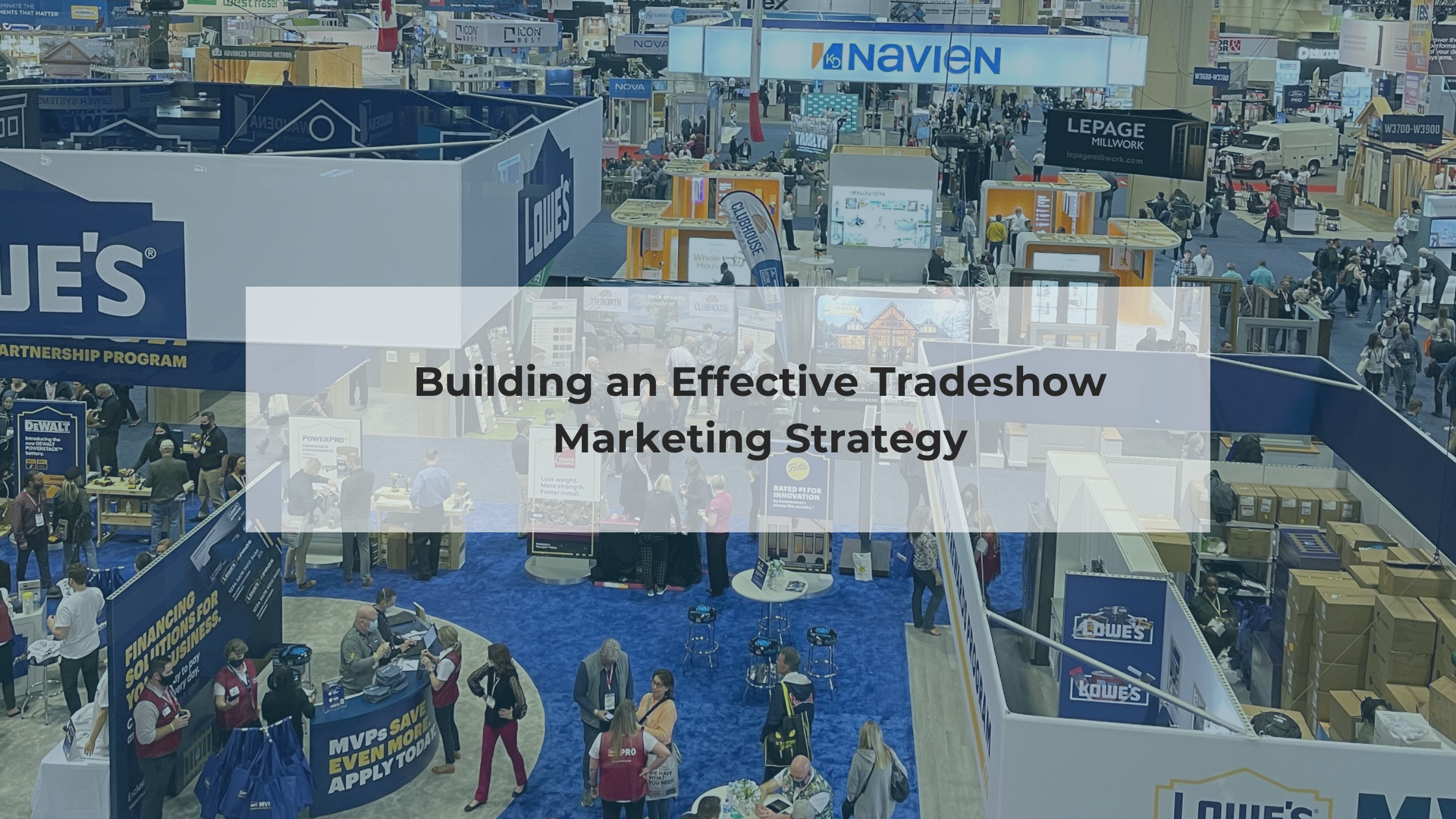Effective Tradeshow Marketing Strategy

Effective Tradeshow Marketing
As we return to our day-to-day after the holiday season, it’s time for tradeshow season. In-person trade shows have bounced back and continue to be one of the most effective marketing tactics for B2B marketers— and their brands — offering a shortcut for connecting with colleagues, customers, and prospects all in one place.
Why are tradeshows important?
Recent statistics from Conference Source indicate that 79% of attendees believe that tradeshows assist them in determining what to buy. As exhausting as they can be, it is a convenient way to target buyers and communicate the benefits of a brand and its products or services. The research from Conference Source also reports:
- 82% of trade show attendees have buying authority.
- 77% attend to find a new supplier.
- 74% of attendees will likely buy a product after seeing it at the show.
If it’s the correct tradeshow for your business, it’s an ideal way to grow and strengthen it.
Are tradeshows effective?
Tradeshow effectiveness strongly depends on various factors, but a pre-, at-, and post-show marketing plan is essential. Let’s face it: you spend a lot of time and money on just one show — from building a booth, shipping, drayage, marketing, and entertainment — which needs to pay off. Need another reason? 70% of businesses generate new leads and create brand awareness from shows.
Building an Effective Tradeshow Marketing Strategy
At Collons Communications, we advise clients to build a strong marketing strategy for each tradeshow. A solid pre-show marketing program to drive attendees to your booth (or stand) and at-show engagement with a strong post-show follow-up so they remember you long after the show has closed can be as simple or complex as needed.
-
Pre- Tradeshow Marketing
Many tradeshows offer ‘FREE’ opportunities or some that can be nominal or the market rate for the product offering and come with your booth price. There are also various marketing opportunities to consider reaching attendees and getting on their agenda, and the tactics below are only a partial list. It will depend on your goals and budget.
-
- Registration Widget: Add to your website to remind visitors about the show and to click to register and promote on your other channels, whether social media or an email campaign.
- Complimentary Show Badge: this uses a specific exhibitor invitation code generated by show management to invite customers and prospects. Typically, these are limited amounts and can be contingent on the size and expense of your booth.
- Product Showcases: shows offer basic (and premium for a nominal cost) showcase pages to promote your brand and encourage attendees to add your company to their show planner.
- Social Media: Create pre-written posts with show branding and booth numbers.
- Awards Program: Shows also have their own awards programs for entering, and many can be free while some may be a nominal cost. Examples include the most innovative products and new product showcases.
- Email: Targeted emails using the show attendee database are effective, and costs are based on a cost per thousand (CPM).
-
At- Tradeshow Marketing
If you’ve done a successful pre-show marketing campaign, you won’t need to spend wasteful dollars on at-show promotions like the directory, dailies, floor clings, expensive signage, etc. Unless your company goal is solely brand awareness, we recommend using more targeted at-show opportunities.
-
- Giveaway or Contest: Attendee giveaways or enter to win contest. We recommend an item of perceived value and give it out in limited quantities. Contests can be trickier; consider a scratch-off game and enter to win (with a questionnaire for instant research feedback). We also recommend that the attendees work hard for that giveaway/contest — they need to do something or learn something to “win” the giveaway or enter-to-win. It creates a sense of urgency and an opportunity to teach the attendees about your company, brand, or service.
- One-on-One Press Meetings: Schedule one-on-one meetings with the attending press during the show. Meetings are informal but informative and last approximately 15 to 30 minutes. It is a great way to disseminate newsworthy information about your company, brand, or service face-to-face and be open to questions.
- Press Briefing: Instead of one-on-one meetings, schedule a press briefing for the morning before the show opens or just before the show closes for the day. Offer a continental breakfast or happy hour. It is best reserved when there is more newsworthy information, such as a new revolutionary product introduction, new facility opening, new CEO, or leadership changes, and offering a chance for a more intimate Q&A setting.
- Digital Opportunities: For shows that offer show apps, consider a banner ad. Banner ads can be exclusive or one of five (or more) brands that will rotate at the top of the app throughout the show. There are other digital opportunities, and they vary by show. We recommend reviewing the show prospectus for cost-effective and results-driven digital opportunities.
- Booth Event: This can be a panel discussion, demonstration, game, contest, etc. Depending on your goals, these are great ways to engage with attendees and the press.
- Video: a 3–4-minute video shot at your booth is a high-profile way to promote your key marketing messages and repurpose them for use long after the show.
- Social Media: live or scheduled posts, social media can be used as an extension of any at-show activities.
-
Post-Tradeshow Marketing
We cannot stress enough that following up after the show is essential to building sales, relationships, and awareness.
-
- Thank You Email: If you scanned leads at the booth, categorize and organize leads and notes (hot, warm, cold, or A, B, C, etc.), then you can tailor messages accordingly. It doesn’t have to be sophisticated — use your CRM to import leads, sort, and draft thank you messages. For each categorized lead, develop a drip campaign to move that lead down your funnel.
- Social Media: Postings on social media after the show.
- Measurement: there are various ways to measure the expense of a tradeshow, and that’s for another time.
It is reported that 76% of all attendees attend tradeshows with an agenda — essentially a short list of exhibits they plan to visit. That’s a significant number, and it’s worth it to make a solid tradeshow marketing strategy to get on their agenda early and continue the promotion so they have a good experience with your company, brand, or service.
If you need help with your tradeshow marketing, contact us. We have experience in tradeshow design and build, marketing campaigns, and even ironing company shirts hours before showtime.
Meet us in person. Let’s grab a cup of coffee or cocktail and rest our feet at the NAHB International Builders’ Show® (IBS) and the NKBA Kitchen & Bath Show® (KBIS) at the end of February.
